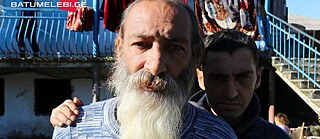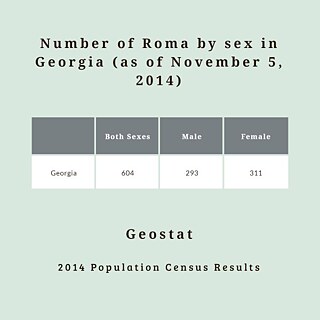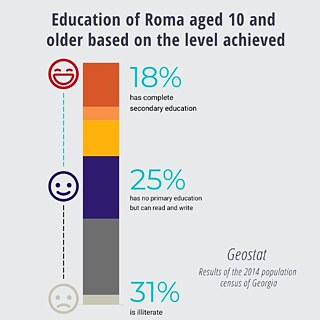Roma Discrimination
This article was produced in the framework of the "Unprejudiced" project with the support of the Eastern Partnership Programme and the German Federal Foreign Office in January 2022.
Authors:
Iryna Sayevich
Anja Lordieck
Ana Kikaleishvili
“They want to kill us, they are threatening us. We are afraid to let our grandchildren into school. Our children are afraid to go to work” - emotionally and frightenedly said the Roma community of the city Irpin, which is near the capital of Ukraine. A dozen women and children in the autumn of 2021 were forced to ask for the protection.

They beg everyone who knows them to confirm that they have never sold drugs.
This video, where they're asking for help, they record against the backdrop of a wall with inscriptions that call to drive out Roma from the city. Inside a neat yard where several Roma families live, they show used fireworks and smoke bombs that several hundred people, mostly men, were blown up near Roma homes the day before.
"Get rid of drug dealers", "Death to drug dealers" and "Get rid of gypsies from Irpen" - shouted men who organized an action against the Roma. All of this they were showing live on social media.
The protest was the result of a small domestic conflict between two Roma teenagers and a local volunteer. The young man said that he had been attacked by the Roma. So the domestic conflict escalated into big xenophobic protests.
Xenophobia against the Roma is widespread not only in Ukraine but throughout Europe and the post-Soviet countries. Roma survey, 2012 and EU-MIDIS II, 2016 – confirm that levels of Roma discrimination in different areas of life remain worryingly high across the EU. Why Roma are discriminated, how attitudes to them have changed over the years, and how to reduce discrimination? We will look for answers to these questions in three different countries in Central and Eastern Europe — Germany, Ukraine and Georgia.
How many Roma live in these countries?

Compared to other European countries, the percentage of Roma settlements in Georgia is much smaller. Nevertheless, they are present in large numbers in urban settlements. According to official Geostat data, the number of Roma in Georgia totals slightly more than 600, but according to unofficial sources, their number exceeds 2000. In an interview with Radio Free Europe, Elene Proshikiani, a spokeswoman for the Roma community, said that in many cases, Geostat staff did not set foot in homes where Roma lived. "The reason for that was either they were not at home, or the fear factor played out."
In 2012, the Georgian government launched a program aimed at registering members of the Roma community to enable them to prepare ID cards. However, more efforts are needed in this regard as well, states a 2017 study by the Georgian Reform Association, GRASS. According to a 2014 report by the Georgian government, "about 80% of Roma living in Georgia have ID and birth certificates." However, these data are less reliable given the difficulty to determine the number of Roma living in Georgia since many of them do not have identification documents.
The living conditions of Roma people are relatively better in Western Georgia compared to the East. In the latter, they do not have registered occupied dwellings, living in temporary shelters and tents.
More Roma live in Ukraine. According to various estimates, between 200,000 and 400,000 people. There is no recent accurate data, as the last census in Ukraine was conducted 20 years ago, in 2001. According to it, 47,917 people indicated themselves as Roma. Census has not been conducted all these years, because it is very expensive, Ukrainian officials state. Ukraine Commissioner for Human Rights Lyudmila Denisova gives another reason. She said that it’s difficult to establish how many Roma live in Ukraine because many of them don't have documents. According to the Monitoring the Human rights situation of Roma in Ukraine that was made in 2014 in Odesa, Kropyvnytskyi and Uzhhorod – from 30% to 40% of local Roma (10%–15% of women) reported that they did not have at least one of the documents necessary to access a range of services. In Mukachevo (Zakarpattia region), only 1,500 of 10,000 Roma had passports. But Roma human rights activist Zola Kondur said that the situation is improving now, because there are public organizations that help Roma get documents.
Problems with documents are widespread throughout Europe. According to US institute of diplomacy and human rights, roughly 70% of Roma and Sinti remain stateless in Europe. The distinction between Roma and Sinti is used only in Germany, Austria and parts of northern Italy. Sinti are descendants of the Roma groups that migrated to German-speaking countries as early as the 14th and 15th centuries. In contrast, Roma are those who came to Germany from the mid-19th century or even in the 1960s as guest workers and in the 1990s as refugees from Yugoslavia. There are no official surveys in Germany on how many Sinti and Roma live there. The reason for this is that since the end of World War II, Germany has generally not collected population statistics and socioeconomic data on an ethnic basis. But estimates range from 70,000 to 150,000.
How discrimination against Roma began?
The discrimination of Romani and Sinti people in Germany started centuries ago and reached its zenith during World War II. In 1943 23.000 Romani and Sinti were deported to concentration camps where about 20.000 of them were killed. Besides, Roma and Sinti who were married to people with German origins were usually not deported. However, they and most of their children were forcibly sterilized.
It was not until 1982, 37 years after the end of World War II, that the genocide of Sinti and Roma was recognized by Chancellor Helmut Schmidt - after Romani and Sinti associations had exerted pressure. Some are still waiting for compensation today.
After the genocide, there was initially no clarification and no support for the Sinti and Roma who returned from the concentration camps. “This was a traumatic experience for those affected, who had lost all trust in the state anyway.” Historian Frank Reuter explains. “Everything was taken away from them during the war. When they came back, they were made out to be criminals. Municipalities put the destitute Roma and Sinti into poverty and slum areas. There they were pushed to the margins of society.”
In Ukraine there was genocide of the Roma people by Nazi too. According to Miriam Nowicz, director of the Warsaw Museum of Ghetto Wrestlers, 300,000 Roma became victims of genocide in Russia, Ukraine and Crimea.
But the treatment of Roma was not always cruel. The first mention of Roma on Ukraine territory dates back to the 15th century. This is data described in the report of the International Group on Minority Rights and the Roma Women's Foundation “Chirikli”. At that time, they were mainly engaged in blacksmithing, barter, horse breeding. They were often colleagues, friends or even godparents with Ukrainians. But the nomadic way of life of the Roma did not suit any of the political regimes that operated in Ukraine. They all tried to settle Roma in one place. Furthermore, in Soviet Union time, the Roma were subjected to Stalinist repression. For example, in May 1944, after the Soviet Union gained control of Crimea, most Crimean Roma were deported to Central Asia. Thousands died on the way to their destination. Some Crimean Roma left areas of forced deportation after Stalin's death.
Since the mid-1950s, Soviet authorities have tried to forcibly resettle Roma, mostly in rural areas and often in conditions that do not meet normal living standards.
In the 1990s, many Roma found themselves below the poverty line. The economies of some post-Soviet countries collapsed at that time, so Roma began to migrate to large cities to find a job. They were forced to live in temporary camps, picking up scrap metal, recyclables for a decade. In the 90s parents often intimidated their children with Roma — head of the Roma program of the International Renaissance Foundation Serhiy Ponomaryov explains.
As for Georgia, most of the Roma migrated here after the Holodomor of Ukraine. According to 2009 data from European Centre For Minority Issues, ECMI, Roma living in Georgia are originally either from Ukraine or Russia. Elene Proshikiani stated that about 40 years ago, there were many more Roma living in Georgia; after the Second World War, their number reached 10,000. The Roma were always looking for better living conditions, and their migration here was due to the fact that Georgia was conflict-free at that time, while they were persecuted in Ukraine.
“Everything has changed and a lot of negatives have accumulated”, Elene Proshikiani, recalls in an interview with Public Broadcaster. “The Roma here have completely withdrawn from the rest of the population. They do not know Georgian, 95% do not even know how to read and write.”
From distance to violence
In Ukraine, discrimination against Roma has even resulted in physical violence. The most known case took place in the summer of 2018 in Lviv.
Late in the evening, a group of men attacked a Roma camp. There were living ten-member of the Roma community that were collecting scrap metal. The men stabbed several members of the Roma community. 23 years old Roma died. Three other people were stabbed. It’s a 10-year-old boy, a 19-year-old man and a 30-year-old woman.
Police soon detained 14 attackers: they had a plan on how they would act, every one had tasks. All suspects were aged 16-17 and one was 20-year-old. The local newspaper reported that the boys had their own YouTube channel, where they kept the video "Safari for Roma". The video was deleted after the attack.
Public figures reacted immediately to that tragedy. The Commissioner for Human Rights, Mayor of Lviv, human rights activists, deputies and others wrote posts on Facebook where they called for the guilty to be punished. But there were those who blamed the victims for the tragedy.
The attack became a key topic in regional and national media.
“Now the level of physical violence has declined, in part because the police are more active in anticipating it. Now the aggression has changed from physical to verbal” the head of the Roma program of the Foundation “Renaissance” Sergei Ponomaryov says.
The Office of the Commissioner for Human Rights has received 13 reports of discrimination against Roma since the beginning of the year till November 2021 and most of them concerned hate speech.
In Germany, antiziganist crimes are not recorded as such, but racist crimes in general. Therefore, the extent is unclear. However, there are individual cases that show that discrimination is partly expressed in violence here as well.
So in 2019, when a German woman attacked a Roma family with a knife in a Berlin subway for racist reasons. In the same year, five young men harassed a Roma family in a caravan in Erbach-Dellmensingen in the Alb-Donau district. At the end of May 2019, one of the men threw a burning torch into the caravan, which extinguished itself after a few minutes.
Violence does not only come from outside of the community. Roma women and girls in Georgia are unable to avoid domestic violence.
Based on a GRASS study, out of 23 Roma participating in a questionnaire survey, 21 stated that they had been victims of violence due to bringing insufficient money home or expressing dissatisfaction with their husbands' cheating. In cases of domestic violence, only husbands are not the ones acting as abusers. Many participants reported they had also been the victim of physical abuse by their family members, mostly parents.
What is the current level of discrimination against Roma?
Discrimination does not always degenerate into violence. However, Roma and Sinti are exposed to everyday racism.
When Ruždija Sejdović left a supermarket on a day in the middle of November 2021 in Germany, he already noticed the disparaging looks of another man who was waiting near his car at the parking lot. “I thought that he was maybe jealous because of my expensive Mercedes. I like large high-quality cars. And he just had an old cheap car.” At that very moment he also thought that this situation may lead to trouble. He tried not to let on and packed his purchases from the shopping cart into his trunk. “I then came up against my shopping cart and it moved a few inches toward the man's car.” Then it went off. “The man started yelling at me: ‘Be careful with your shopping cart, I could call the police! Take your cart and go back where you came from.”, Sejdović describes the situation. Although the man seemed a little strangely awkward, Sejdović was a little scared. “I left quickly and even forgot to take my chip out of the shopping cart”, he says. What stays was a bad feeling about being identified as non-German only because of his appearance. Although he has lived in Germany for over 30 years and feels like a person from Cologne, no matter what anybody says.
Even today, Romani and Sinti people are discriminated against in Germany. This is shown by the report of the Independent Commission on Antiziganism from 2021 which was constituted by the Federal Ministry of the Interior. Surveys show that the minority of Sinti and Roma is one of the groups towards which the German population expresses the most open rejection.
“This does not necessarily mean that the rejection towards other groups is lower. It is rather probably because antiziganism, is more socially accepted in Germany than, for example, anti-Semitism.” The political scientist Markus End, who was a member of the commission, explains. Another member, the Historian Frank Reuter, also says this: “Antiziganism has been deeply embedded in the bourgeois self-image for centuries.”
There are also surveys which aim to measure how widespread antiziganism is among the German population. The results are very different and their methods are, according to the Independent Commission on Antiziganism, methodologically not entirely clean for several reasons. Nevertheless, they all point in the same direction: there is a high level of antiziganist perceptions in the German population and Roma and Sinti face a high risk of discrimination.
A similar survey on social distance was conducted in Ukraine by The Kyiv International Institute of Sociology. It shows that the largest social distance is between Ukrainians and Roma people.
To be fair, the same research conducted in the same way in neighboring countries — Poland and Russia showed the same results.
On November 24, 2016, the Georgian media outlet "Digest" shared a video on Facebook titled "Social experiment in Tbilisi - a Zigan gives money."
The video shows a social experiment where Roma children offer money to passers-by. Most people react negatively to an offer and rudely try to avoid them.
The organization "Partnership for Human Rights" (PHR) addressed the post to the Public Defender of Georgia, considering that the word "Zigan" has a discriminatory, xenophobic, degrading meaning and incites hatred towards Roma as an ethnic group.
The ombudsman responded to the statement by saying that the purpose of the video was to demonstrate how rude members of the community treat children living and working in the streets. However, the author violated the media standards that ensure the best interests of the child.
The ombudsman stated that the word "Zigan" has a negative connotation and reinforces the stigma attached to Roma children. The body appealed to the media outlet to remove the controversial video from the Facebook page and in the future, not to use terms that would insult the dignity of members of the vulnerable group and/or reinforce stigma and stereotypes about them.
The video was removed from the Digest Facebook page. However, the original one is still available on YouTube.
Hate Speech and Stereotypes
In Germany, Sinti and Roma are regularly confronted with hate speech on the Internet. This is even more true for social networks. There, hate speech extends to dehumanization and even calls for violence. The use of language is relatively explicit and aggressive. There is direct talk of rejection, ridicule and violent fantasies.
Stereotypes of Sinti and Roma as foreign and exotic are reproduced again and again in literature, in art and music, and in film. Journalistic reporting on Roma and Sinti is also characterized by such stereotypes.
In Georgia, there is a deep seated fear in the society towards Roma.
"Many people are afraid of us because they have stereotypical thoughts," said one of the Roma men in the Kobuleti GRASS study. In Leninovka, one of the Roma noted that during the school period, his classmates and their parents' negative views and xenophobic attitudes towards Roma created many problems for him. According to GRASS, negative stereotypes about Roma are partly caused by a lack of knowledge about the culture of Roma and because of the concept the media created about them.
"We think that Roma are thieves, or they can hypnotize you, take away your jewelry. This is no longer the case,” Elene Proshikiani notes. However, these stereotypes emerged in the early 20th century, when theft was one of the main means of living for Roma. "They stole horses from one another. The bigger number of horses would give you leadership in the community. They also stole from other Roma, while others robbed Georgians and non-Georgians."
According to ECMI, Roma is perceived by the general public as a mass of dirty and uneducated people who know only begging and street trading. Stereotypes about the Roma are facilitated by the presence of begging children roaming the city streets, who, in many cases, are not Roma at all. The widely used Russian term "Zigan" has been coined to refer to nomadic children wandering the streets, regardless of ethnicity.
Roma are known to be disobedient and free-spirited. "Roma do not like to be framed, they do not like to be instructed on what to do," Elene mentions. Making passports, which was considered one of the forms of obedience, was a sign of weakness for them. However, it is no longer the case. "They know why they need these documents. Because the source of their income is social assistance. Almost 90% of Roma living in Georgia are considered to be of a very low social class. They know that if they do not have an ID card and Georgian citizenship, they will not receive this assistance."
However, they face frustration when they apply to state agencies. "When a Roma person goes to one of the agencies and wants to get a document, mistreatment leads to a breach of trust," Elene states. This is confirmed by the research of ECMI. In terms of document ownership, the situation is dire in Gachiani, Lilo, and Telavi, where about half of the Roma population has no documentation. The reason for this situation on the one hand is the passivity of the Roma and refraining from appearing in the relevant official bodies, on the other hand, it is the result of the lack of interest of these official structures in arranging documents for the Roma.
If the level of physical violence decreased over the years in Ukraine, the level of hate speech is consistently high.
“Until 2016-2015, even official structures published some reports with Antiziganism content. And then it was republished by the media. Since 2015, official structures, such as the police, the prosecutor's office, and local authorities, have stopped doing so. But the media still continues. Mostly in Zakarpattia and Odesa region, where the largest Roma communities live,” says Serhiy Ponomaryov, head of the Roma program of the International Renaissance Foundation.
Even higher levels of hate speech are on social networks. There are even some groups where people discuss the so-called "Safari" on Roma. This refers to the "hunt for Roma". It is called an analogue of safari on animals in Africa. Most users stereotypically talk about the lives of Roma, describing them as thieves or beggars, or ridiculing their way of life. This is data from a Roma woman foundation “Chirikli” and International Organization ERGO Network.
Discrimination and education
The school attendance rate is extremely low among Roma in Georgia. "I want to have a big house. Lots of money, a car, a big pool in the back of the house. I want to be a millionaire." This is how Roma children dream. However, they fail to realize their desires.

ECMI stated that in any Roma settlement in Georgia, only a small number of children are enrolled in school, and in some settlements, for example, Lilo, Samgori, Batumi, not a single child attends school.
There are several reasons for the lack of education among Roma in Georgia.
Dropping out of school is frequent and it is the result of direct discrimination by classmates and teachers, as focus groups note in the 2017 GRASS study. This problem is especially relevant in Leninovka, Kakheti region, Georgia. Here, the issue of discrimination by the non-Roma population is one of the main barriers to the integration of Roma in the region.
Early and forced marriages are also considered to be one of the obstacles to getting an education. According to a survey conducted in Dedoplistskaro, the average age of marriage among respondents ranged from 13 to 15 years. In Rustavi, a community leader known as the "Baron" stated that marrying 13-14 years old girls in the Roma community is a norm. However, this practice is slowly losing its force as they already know that early marriage is illegal and it might have an unpleasant outcome.
According to Article 1108 of the Civil Code of Georgia, the marriage shall be permitted from the age of 18. However, it is also possible at the age of 16, with the consent of a custodian.
Elene Proshikiani talks about the fact that early marriages in major cases are decided by parents, Roma girls themselves do not want to get married. "In my practice, there were two cases when a girl ran away from home after our conversation because she did not want to get married. She was already 18 and she was ready to learn, but in many cases, parents decide girls' fate." Elene believes that at the municipal level, a local policeman should work with such families and inform the agencies about them, but they do not do this and young girls do not even know who to turn to.
A GRASS study noted poverty and low financial incomes of Roma among the barriers to accessing education. A Roma girl stated that "most of the children are unable to go to school due to financial constraints, even though their families are eager to do so." According to GRASS, the government needs to take care to reduce expenses needed for schooling and provide free transportation for school children, especially for the ones living in villages and remote settlements.
On the other hand, parents send their children to street trade or beg, which is a source of additional income for the family. In some cases, parents leave their children at home to do household chores. Additionally, they do not understand the need for education, since they have not received an education either.
“Unless anyone explains to Roma why education is important and why it is necessary to bring children to school, they will not be able to understand it themselves”, Elene Proshikiani says. “They believe they already live perfectly: Children at home or in the market with their mother, and a husband at home, taking care of children or just living like a lazy bum.”
This is not the case everywhere in Europe. Nevertheless, there are problems for Roma and in schools. The Advisory Committees of the Council of Europe in its 2018 report notes xenophobia against Roma in Ukraine. Segregated and sub-substandard schools for Roma children still exist. Furthermore, Roma children are overrepresented in so-called ‘special education’ schools, where teaching follows curricula adapted for children with special needs. The same is the case for Roma and Sinti in Germany.
Moreover, there are examples of discrimination against Roma in school textbooks. For example, experts found a math exercise where the thief was described as a Roma person.
Educational xenophobia was exacerbated by the pandemic. Serhiy Ponomaryov says that the school spent a long time on distance learning in 2020, so Roma children who didn’t have gadgets weren’t able to study.
Structural Antiziganism

In Germany, Romani and Sinti people are refused for job interviews or even dismissed when it becomes known that they are Romani or Sinti people. It happened in the case of Ruždija Sejdović. The job agency wanted to find Ruždija Sejdović an apprenticeship at a print shop in 1989. Everything went well until he mentioned by the way that he was a Roma. The next time he visited the referee who was very friendly until then suddenly ended her support without an explanation and said that he needs to search for work by himself.
“I was pretty sure that this was because I said I am a Roma person”, Sejdović says.
In Germany, Romani and Sinti people are affected by discrimination on the housing market and inhumane housing conditions are usual for them. They often have to endure racist attacks by their neighbors.
Correspondingly, in a study conducted by the Independent Commission on Antiziganism, Roma and Sinti report that they have poorer access to education, housing, employment and health care and are treated unequally and discriminated against by government agencies in Germany. This is also true for Roma in Georgia. In addition, there are other problems such as lack of knowledge of the Georgian language and a lack of proper documentation (including ID cards and passports).
Roma in Ukraine also have problems with employment. According to a 2018 UN Women report, only a third of Roma men and women had jobs before the pandemic in Ukraine. Most often it’s informal and seasonal work, such as selling products in markets. Many Roma lost their jobs because of the pandemic.
Discrimination against Roma has been exacerbated by the coronavirus in general. In April 2020, the Vox Populi Agency made a sociological survey by asking Roma: "Did they feel a worse attitude to themselves at the time of the pandemic?" 12% of respondents said that the level of discrimination had increased, and it was mostly in everyday life.
Serhiy Ponomaryov spoke about the ethnicization of the pandemic.
“In everyday life, people regularly accused the Roma of spreading the COVID-19 because they were allegedly not organized, didn’t comply with quarantine conditions or self-isolation,” Serhiy Ponomaryov says.
Moreover, discriminatory statements were made by public figures. In April last year, the mayor of Ivano-Frankivsk said at a working meeting that Roma should be forcibly removed from the city because he thinks that they are worsening the epidemic situation. He apologized for his words later. This year, similar statements were made by the mayor of another city - Rivne.
But discrimination in the health care system were even before the pandemic. According to Roma human rights activist Zola Kondur and her research in Ukraine there is a problem with so-called "Roma wards in hospitals". It’s wards only for people of this ethnicity.
“Doctors explained this by the fact that the Roma ask to be placed in those wards by themselves, because they feel more comfortable with other Roma, they can communicate in their own language and support each other. But if you will look at the reports of the European Roma Center in 2018-2019, you will see that the quality of medical services for people who are in such segregated wards was much lower than in regular wards and the conditions were also very bad. Now the condition of such chambers has improved, some of them have been renovated," said Zola Kondur.
Also, there is police xenophobia. The Advisory Committees of the Council of Europe in its 2018 report notes frequent raids and searches of Roma settlements, cases of police violence against Roma and a slow response to calls about domestic violence in Roma families. In fairness, Ukraine does not have ethnic statistics on the number of crimes committed against Roma or by Roma.
The German Asylum Policy Case
Current asylum policy makes the life of Romani people who immigrated to Germany in the last 30 years very difficult. The German state differentiate between legitimate and illegitimate asylum seekers – Romani people are often equated with illegitimate asylum seekers. The discussion about this began in the 1990s when there were attacks on refugee homes. These were attributed to a poisoned climate by certain immigrant groups - the Roma. This argumentation is often used as legitimation for the following asylum policy. "The tightening of asylum was based on antiziganistic lines of argumentation. Racism in the population was seen as anargument for the tightening and not seen as the real problem. " comments Markus End.
The German government wanted to give their population the promise that only people who are admitted from an unsafe country of origin where they cannot live safely. Others fleeing poverty should not be able to take advantage of the German welfare state. In this case, this refers to the "asylum-abusing" Roma people. Therefore, safe and unsafe countries of origin are defined and people from so-called safe countries of origin are deported. This asylum policy led to the definition of Serbia, Macedonia and Bosnia-Herzegovina as safe countries of origin in 2014 and Albania, Montenegro and Kosovo in 2015. However, according to the aforementioned report by the Independent Commission of Antiziganism, the situation of Romani people in these countries cannot be considered as safe. They are racially discriminated against and socially and economically excluded.
The German asylum policy led to a situation in which Romani people lived in Germany for three decades without secured residence status. According to the Federal Roma Association, the missing residence status together with everyday antiziganist discrimination, means that Roma have difficulties finding adequate housing or supporting themselves financially. Some of them marry in refugee homes, get children in refugee houses. “It is as if they live in a parallel society. For many children, it is similar to growing up in a prison, because who goes in and out is always monitored. When they come to school, they are very afraid because they live so differently from other children. And of course they cannot bring anyone home with them.”, Ruždija Sejdović explains. He works for a school program that helps those children to get used to school.
Then there are also cases of people being deported who have lived in Germany for 20 years and came from their countries of origin as children. In some cases, however, they have no relationship to these countries at all, let alone a corresponding citizenship. They are deported to a country where they are considered illegal.
Difficulties with intermarriages
Also, there is a dual attitude towards interethnic marriages between Roma and Georgian.
Eliso, a 50-year-old Georgian woman, got married to a Roma 20 years ago. The Roma family welcomed her very kindly, but there was an unkind reaction from her relatives: All of them were scolding me, speaking of my husband in a spiteful way, asking me what forced me to take this step, and eventually, everyone turned their back on me.
On the other hand, Roma's view about intermarriages is relatively more open-minded. Old traditions forbade marriages with other ethnicities. Elene Proshikiani mentions that for this, they were punished and expelled from the community. There were several such cases in Georgia. However, many Roma point out that traditions have changed. I love short dresses, it fits me, says a young Roma girl from Georgia. If my husband were a Roma, I would have to wear long dresses, but I can wear a short dress with a Georgian. Even so, my father does not want me to marry a Georgian.
How to reduce discrimination against Roma?
Elene Proshikiani, a representative of the Roma community in Georgia, sees the problem of discrimination against Roma in a lack of interest from state structures.
“If we show the Roma community that we care about their problems and their interests, we will definitely get feedback from them. However, no organization presents the problems of the community to the relevant state structure” Proshikiani says.
Roma maintains their culture, identity, and language, so the problem of assimilation does not lie in the community. However, they do not speak the state language, do not have friendly relations with Georgians, and do not consider themselves part of society.
“First of all, it's the fault of the information vacuum where the Roma live. On the other hand, it is caused by fear and a lack of trust. 90% of Roma are afraid that their children will be ridiculed in schools and kindergartens because of their background, `` a representative of the Roma community in Georgia added.
According to GRASS, it is important to start raising awareness about domestic violence at an early age, so that young Roma can recognize the signs of violence from the very beginning and thus empower young people to be able to improve the conditions in their community.
GRASS also noted that it is necessary to remove barriers to registration, including the cost of obtaining an ID card, to give low-income families an access to it. Registration of children should be a priority so that they can get a school education.
The study also points to the need for changes in the Civil Code. Its purpose is to prevent the early marriage of minors even with the consent of their parents.
As for the Roma themselves, it is necessary to raise awareness on the risks of early marriage and early pregnancy, the importance of elections, and political participation.
The Independent Commission on Antiziganism of Germany formulates various recommendations for action. Among others, it is the comprehensive recognition of the National Socialist genocide of Roma and Sinti, the appointment of a commission for the reappraisal of the injusticec committed against Roma and Sinti, the recognition of refugee Roma as a group particularly worthy of protection, and the implementation and consolidation of participation structures. Historian Frank Reuter sees the commission as a milestone and an expression of advanced democracy in Germany. “The German government has commissioned a report that takes a critical look at its policies. In what other country is there such a thing?” Markus End, who like Frank Reuter was himself a member of the commission, is skeptical. "The government has thus primarily given in to political pressure. And that will continue to be necessary." In the coalition agreement of the new federal government, which was elected at the end of last year, he misses clear measures against antiziganism. It remains to be seen whether the report will be followed by action. Besides, Ruždija Sejdović would like Roma and Sinti to be allowed to help themselves and for commissions against antiziganism to be composed of equal numbers of Roma and non-Roma. However, politicians should talk to Roma and Sinti associations and not decide over their heads.
“And media should stop to only report about Romani and Sinti people as poor victims. This template has fit far too well in the eyes of many but does not reflect the reality of Roma and Sinti who no longer live on the margins of society and never wanted to live there”, Ruždija Sejdović said.
The same position has Ukrainian Roma human rights activist Zola Kundur.
"There is a lack of positive, successful stories about the life of the Roma. For example, how they protect Ukraine from Russian aggression,” the human rights activist said.

